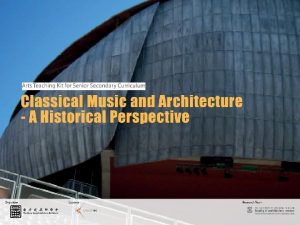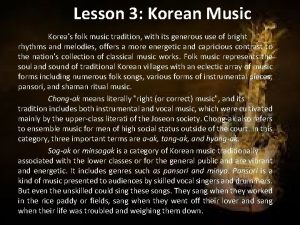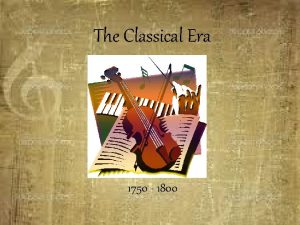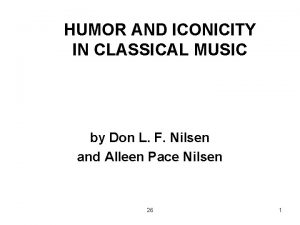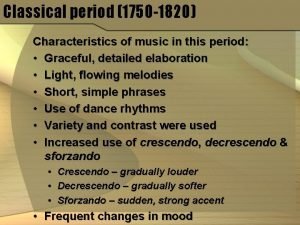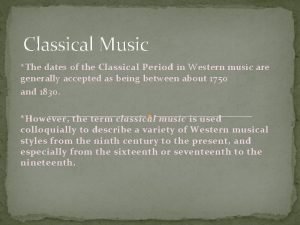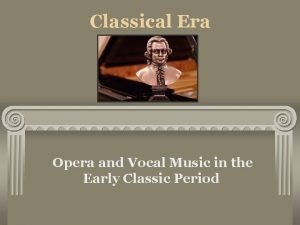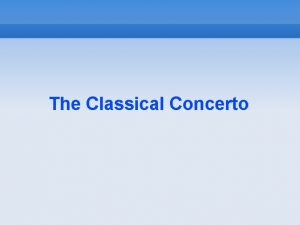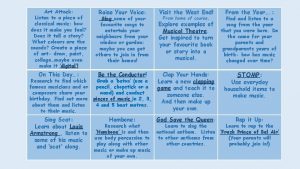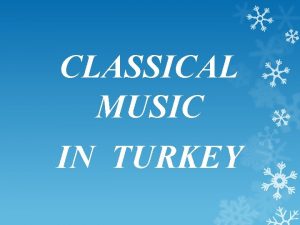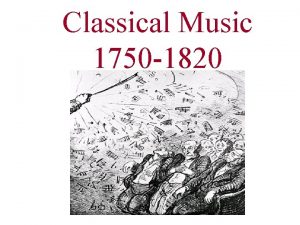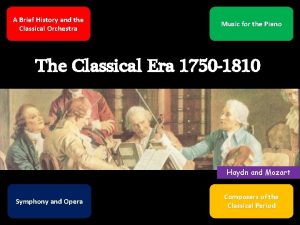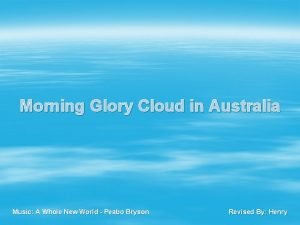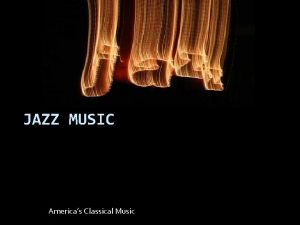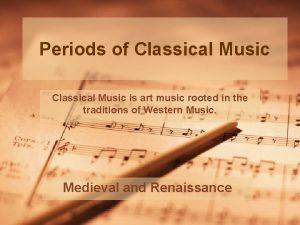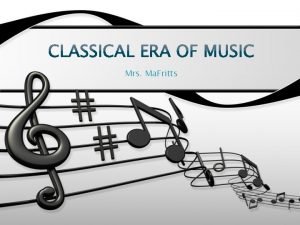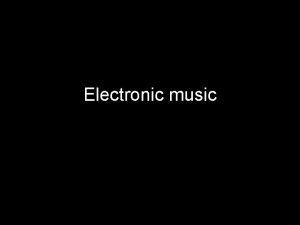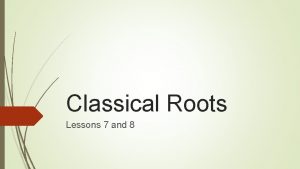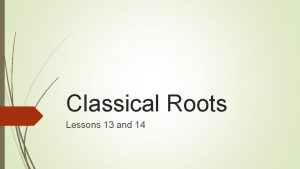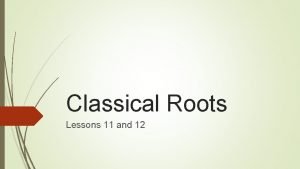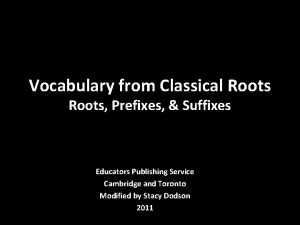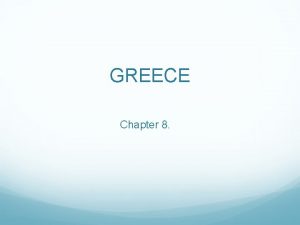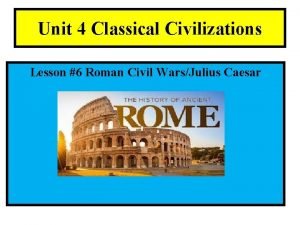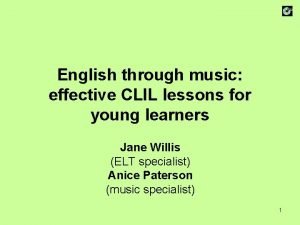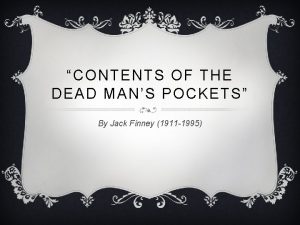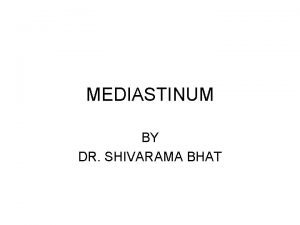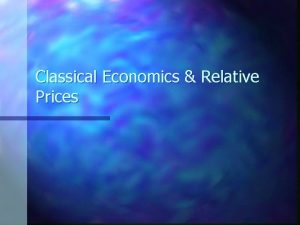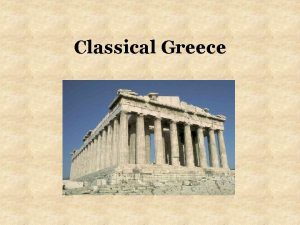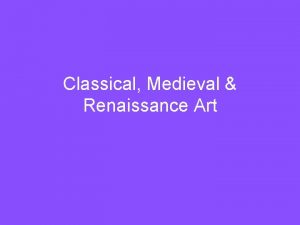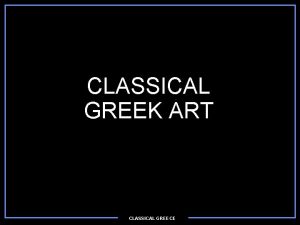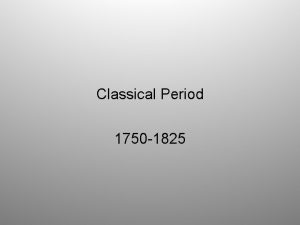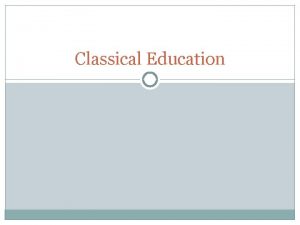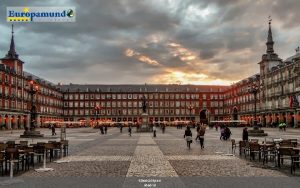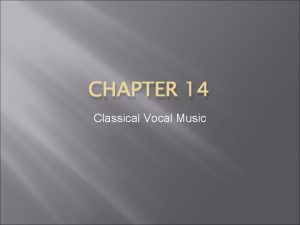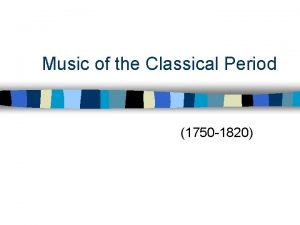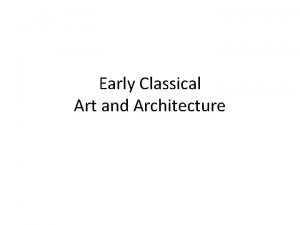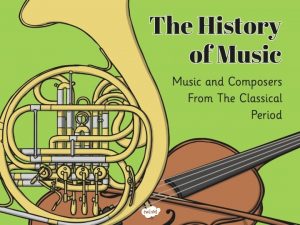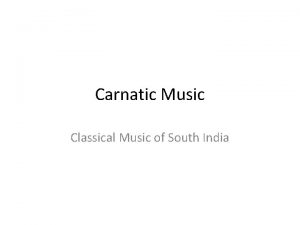CONTENTS Lesson 1 Classical Music and Architecture A










































- Slides: 42


CONTENTS • Lesson 1 – Classical Music and Architecture — A Historical Perspective • Baroque period (1600 -1750) • Classical period (1750 -1820) • Romantic period (1820 -1900) • Lesson 2 – Contemporary Music and Architecture | Classical Music and Architecture |

Lesson 1 Classical Music and Architecture A Historical Perspective Chapter of York Minster, England | Classical Music and Architecture | Lesson 1 – Classical Music and Architecture – A Historical Perspective

“All religions, arts and sciences are branches of the same tree. All these aspirations are directed toward ennobling man‘s life, lifting it from the sphere of mere physical existence and leading the individual towards freedom. ” —Albert Einstein, scientist Ronchamp Chapel, France, Le Corbusier, 1954 | Classical Music and Architecture | Lesson 1 – Classical Music and Architecture – A Historical Perspective

Can you think of any examples of how different forms of art relate to each other and to society? | Classical Music and Architecture | Lesson 1 – Classical Music and Architecture – A Historical Perspective

The overlapping terrain of the arts | Classical Music and Architecture | Lesson 1 – Classical Music and Architecture – A Historical Perspective©Chloe Lun 6

“I call architecture frozen music. ” — Johann Wolfgang von Goethe, author The Pantheon, Rome | Classical Music and Architecture | Lesson 1 – Classical Music and Architecture – A Historical Perspective©Chloe Lun 7

Music • intangible and ephemeral • the most abstract of all art forms Architecture • perhaps the least abstract • it plays a vital role in everyday life and can be experienced with all the senses The painted dome of St Paul’s Cathedral, London | Classical Music and Architecture | Lesson 1 – Classical Music and Architecture – A Historical Perspective

Architecture • is experienced in time - Architecture is just as abstract as music in that a space can only be experienced in the moment • structural associations with mathematics - A piece of music can be divided into a number of movements of different tempos and rhythms, a building is likewise structured by repeating elements and proportional relationships. Park Güell by Antonio Gaudí, Barcelona | Classical Music and Architecture | Lesson 1 – Classical Music and Architecture – A Historical Perspective 9

What music to fill a space with? Play excerpts of the suggested pieces and discuss which piece is more suitable for each of the places shown in the photos above. What makes us associate a certain type of music with a certain type of space? | Classical Music and Architecture | Lesson 1 – Classical Music and Architecture – A Historical Perspective

Baroque Period (1600 -1750): Ornaments, theatricality & formulation An example of Baroque architecture: Trevi Fountain, Rome | Classical Music and Architecture | Lesson 1 – Baroque Period

Renaissance (1400 -1600) • began in Italy and spread across Europe from the 14 th to 17 th century • a comprehensive transformation of all aspects of society including the arts, science, religion, economy and politics • the celebration of human potential and creativity Courtyard of Palazzo Strozzi, Florence | Classical Music and Architecture | Lesson 1 – Baroque Period 12

Renaissance architecture Characteristics • Pure geometric forms • Relationship to human Major building types • Palazzo (Italian ‘palace, ’ a large and imposing urban residence) • Church External façade of Palazzo Pitti, Florence | Classical Music and Architecture | Lesson 1 – Baroque Period 13

Renaissance music Characteristics • Polyphony • Vocal music was more important than instrumental music. • No extreme contrasts of dynamics, tone or rhythm. Calm, harmonious and blended texture. • Church music and secular music • During the late Renaissance, the music evolved to become ‘Mannerist’ in style • Increased chromaticism, establishing the basis for the development of Baroque music. Musical instruments • Bowed strings: viol (similar to a cello), hurdy-gurdy (a mechanical violin-like instrument with valves and a wheel) • Plucked strings: Lute • Wind / brass: trumpet, horn-pipe, recorder, shawm, bagpipe • Percussion: tambourine | Classical Music and Architecture | Lesson 1 – Baroque Period External façade of Palazzo Pitti, Florence 14

Baroque (1600 -1750) • an era of calmness and rationality • Both music and architecture displayed elaborate ornamentations and strong emotions • rejected the human-centred beliefs and harmonies of the Renaissance • depict the conflicts between man and the environment. The curved portico of St. Paul’s Cathedral, London | Classical Music and Architecture | Lesson 1 – Baroque Period 15

Baroque architecture Characteristics • Architects treated buildings as sculptures covered with carved decorations. Baroque buildings were colossal with bold masses • Buildings incorporated many visual arts like painting and sculpture • Visual illusions and play were popular • Theatrical lighting effects, and strong contrast between light and shadow • Use of oval shapes and creation of a sense of movement with curving forms Major building types • Church • Palace St. Peter’s Basilica, Vatican City | Classical Music and Architecture | Lesson 1 – Baroque Period 16

Baroque music Characteristics • Development of the major-minor tonalities still in use today • Formation of the orchestra • Polyphony • One emotion throughout the piece • Sudden and strong contrasts rather than a gradual change in dynamics. Major forms • Opera • Oratorio • Sonata • Prelude • Fugue • Concerto • Suite (a collection of music for dances) | Classical Music and Architecture | Lesson 1 – Baroque Period 17

Baroque music Important composers • G. F. Händel (German-British) • J. S. Bach (German) • Antonio Vivaldi (Italian) Musical instruments • Violin became a dominant instrument • Harpsichord • Organ A harpsichord — note the elaborate decorations, small keyboard and the absence of pedals | Classical Music and Architecture | Lesson 1 – Baroque Period 18

St Peter’s Basilica St. Peter’s Basilica at Vatican City in Rome was mostly designed by Michelangelo in late Renaissance style. The oval-shaped piazza in front was designed later, in the early Baroque, by Bernini. | Classical Music and Architecture | Lesson 1 – Baroque Period 19

St Peter’s Basilica The dome • The oval-shaped piazza is an example of how Baroque architects played with optical illusions. • As the width of the piazza is shorter than its depth, a visitor entering the piazza will perceive it to be larger than it really is. • This creates a dramatic, overwhelming architectural experience. | Classical Music and Architecture | Lesson 1 – Baroque Period 20

Classical Period (1750 -1820): Balance and elegance L’église de la Madeleine (Madeleine Church), Paris | Classical Music and Architecture | Lesson 1 –Classical Period 21

Classical period: music and architecture of the Age of Enlightenment • From the 18 th century onwards, artists, musicians and architects began to turn away from the excessive Rococo style and enter into the Classical period • The Classical period in music (1750 -1820) roughly corresponded to Neoclassicism in architecture (1700 -1900) and the Age of Enlightenment in history • | Classical Music and Architecture | United States Capitol, with Roman architectural elements such as the dome Lesson 1 –Classical Period 22

Neoclassical architecture (1700— 1900 or 18 th—late 19 th century) Characteristics • Resurgence of interest in classical (ancient Greek) architecture, reflected by the use of classical architectural elements • Emphasis on symmetry, proportion and geometry • Clean forms Major building types • Civic buildings White House, Washington D C, a Neoclassical building Examples • Lansdown Crescent, Bath, England by John Palmer (1789 -93) • White House, Washington DC, USA • British Museum, London | Classical Music and Architecture | Lesson 1 –Classical Period 23

Classical VS Neoclassical | Classical Music and Architecture | Lesson 1 –Classical Period 24

Classical music (1750— 1820) Characteristics • The size of the orchestra increased while the more intimate form of chamber music also developed • Homophonic • Texture is less complicated than that of Baroque music. • More variety in dynamics and emotions • Emphasis on balance and control, beauty and elegance Major forms • Sonata • Opera • Symphony • Concerto (a piece written for a solo instrument) Royal Crescent (1767 -1774), Bath, England, designed by John Wood © Rwendland - Wikipedia User | Classical Music and Architecture | Lesson 1 –Classical Period 25

Classical music (1750— 1820) Important composers • Joseph Haydn (Austria) • Wolfgang Amadeus Mozart (Austria) Musical instruments • The piano was invented • The harpsichord was gradually abandoned • Brass and woodwind sections grew more important The Legislative Council Building, Hong Kong | Classical Music and Architecture | Lesson 1 –Classical Period 26

Romantic Period (1820 -1900): Passion and diversity Houses of Parliament, London is in the style of the Gothic Revival | Classical Music and Architecture | Lesson 1 – Romantic Period 27

Romanticism in arts and the Romantic period in music • The Classical period was succeeded by the Romantic period in the mid-19 th century • Romanticism arose as a reaction to industrialization • Beauty of nature and the idyllic past as a revolt against the encroaching machine age • Sought spirituality in Gothic arts • Musical instruments were improved ‘Monastery Graveyard in the Snow’, painted by the Romantic artist Caspar David Friedrich in 1817 -19, shows a Gothic ruin in a natural landscape, an image typical of the Romantic ideal. | Classical Music and Architecture | Lesson 1 – Romantic Period 28

Romanticism in architecture — Gothic Revival (1740 -1920 s) Characteristics • Return of interest in Medieval antiquities and Gothic castles • Iron used as a structural material to create new Gothic forms material • Unlike carefully proportioned Neoclassical architecture, Neo-Gothic architecture, like Gothic, was meant to impress and humble men with its dramatic • Heights and pointed features Examples • Opéra by Charles Garnier, Paris (1862 -75) • Église (church of) St Augustin by Victor Baltard, Paris • (1860 -71) Opéra, Paris | Classical Music and Architecture | Lesson 1 – Romantic Period 29

Romantic period in music Characteristics • More personal and emotional than classical • Richer harmonies • Increased use of chromaticism (half tones) and discords • Larger range of pitch and volume due to improvements in instrument design • Incorporation of folk music elements • The soloist became more important Major forms • Waltz and other music written for dance • Étude • Programme music (music that tells a story) • Incidental music (background music for a play) • Suite (a collection of several pieces of music intended for a play) A Baroque period spinet (a small harpsichord) with only 50 keys | Classical Music and Architecture | Lesson 1 – Romantic Period 30

Romantic period in music Important composers • Ludwig van Beethoven • Pyotr Ilyich Tchaikovsky • Johannes Brahms • Frederic Chopin • Franz Schubert • Antonin Dvořák • Felix Mendelssohn Examples • Symphony • Waltz • Music for soloists • Étude • Inspired by other art forms A modern piano with 88 keys and 3 pedals © Gryffindor - Wikipedia user | Classical Music and Architecture | Lesson 1 – Romantic Period 31

Lesson 2 Contemporary Music and Architecture Philharmonie, Berlin | Classical Music and Architecture | Lesson 2 – Contemporary Music and Architecture 32

“Form follows function. ” —Louis Sullivan, architect “Art and technology - a new unity —Bauhaus motto, 1923 Unité d’Habitation, Marseille, designed by Le Corbusier | Classical Music and Architecture | Lesson 2 – Contemporary Music and Architecture

Contemporary music and architecture (1900 present) — exploration and evolution • Emerge in the 20 th century • In music, new techniques and ideas such as ‘twelve tones’ and ‘phasing’ were explored. • In architecture, modernists sought to create a new spatial language with the latest technology. • Fusion of ideas: West vs. East, ‘noise’ vs. music • Architecture began to depart from traditional forms • The motto ‘form follows function’, was first coined by American architect Louis Sullivan • The movement began with Art Nouveau, Art Deco, then evolved at the Bauhaus and in the International Style to gradually shape the concrete, glass and steel cities of today. City Hall, Hong Kong | Classical Music and Architecture | Lesson 2 – Contemporary Music and Architecture 34

| Classical Music and Architecture | Lesson 2 – Contemporary Music and Architecture

| Classical Music and Architecture | Lesson 2 – Contemporary Music and Architecture


What is next for music and architecture? Please share your own experience of enjoying music in a particular time and space. • Do you go to classical concerts in a concert hall? • Do you listen to your own mp 3 s while travelling on the MTR? • Do you like singing in the bathroom with the special acoustics? • Or, like modern composers, do you like listening to the sounds of the city? How would you compare space and time in architecture and music in terms of the following aspects: • Experience • Composition | Classical Music and Architecture | Lesson 2 – Contemporary Music and Architecture

Summary of contemporary music and architecture Modernism in architecture Some of the characteristics: • Use of ‘modern’ materials: concrete, glass and steel and new construction technology • Notably less nonfunctional ornamentation • Emphasis on ‘form follows function’ • Clean lines and forms • Freedom in structure and form Major building types: • Any building type Classical music of the 20 th century Characteristics or new developments: • Twelve-tone technique (first developed by Arnold Schoenberg) • Atonality • Dissonance • Elements of folk music • Noise and silence • Chance / indeterminacy Major forms: • No standard form CCTV Headquarters, Beijing, OMA, 2012 | Classical Music and Architecture | Lesson 2 – Contemporary Music and Architecture

Summary of contemporary music and architecture Modernism in architecture Major trends: • Art Nouveau • Art Deco • Bauhaus/International Style • Minimalism • High-tech/structural expressionism • Postmodernism Important architects: • Le Corbusier • Louis Kahn • Frank Lloyd Wright • Mies van der Rohe • I. M. Pei • Tadao Ando | Classical Music and Architecture | Classical music of the 20 th century Influence: • Folk and pop music • Eastern philosophy • World music • Modernisation and city living Important composers: • Debussy • Stravinsky • Prokofiev • Gershwin • Schoenberg • John Cage • Steve Reich Barcelona Pavilion by Mies van der Rohe, 1929 (reconstructed in 1986) Lesson 2 – Contemporary Music and Architecture

Summary • All arts deal with space and time. Music and architecture have both passed through stages of tangible and intangible development in response to their time. • Music and architecture from the Baroque period (1600 -1750) feature elaborate ornamentations and strong emotions. | Classical Music and Architecture |

Summary • Classical music and architecture (1750 -1820) display a search for balance and elegance. • Romantic music and architecture described by Passion and diversity (1850 -1900). • In the 20 th century, new forms of music and architecture were tested. Many distinctive styles have evolved due to new technology and innovations. | Classical Music and Architecture | 42
 Classical music vs romantic
Classical music vs romantic Classical music summary
Classical music summary Online music portfolio
Online music portfolio Used in both the folk and classical court music of korea
Used in both the folk and classical court music of korea Classical music eras
Classical music eras 1750 1825
1750 1825 Modern era music
Modern era music Music timeline
Music timeline Humor in classical music
Humor in classical music Music of the classical period (1750 to 1820)
Music of the classical period (1750 to 1820) He is the father of symphony and string quartet
He is the father of symphony and string quartet Era opera
Era opera A classical concerto is a three movement work for
A classical concerto is a three movement work for Art attack classical music
Art attack classical music The approximate dates of the baroque period in music are
The approximate dates of the baroque period in music are Classical turkish music
Classical turkish music Music of classical period 1750 to 1820
Music of classical period 1750 to 1820 A brief history of classical music
A brief history of classical music Morning glory classical music
Morning glory classical music Jazz america's classical music
Jazz america's classical music Time periods of music
Time periods of music Classical melodies are tuneful and easy to remember
Classical melodies are tuneful and easy to remember 8 elements of music
8 elements of music Music that employs electronic music
Music that employs electronic music Instrument used in pamulinawen
Instrument used in pamulinawen Vocabulary from classical roots lesson 7 and 8 answer key
Vocabulary from classical roots lesson 7 and 8 answer key Vocabulary from classical roots lesson 13 and 14 answers
Vocabulary from classical roots lesson 13 and 14 answers Classical roots lesson 11 and 12 answer key
Classical roots lesson 11 and 12 answer key Match each idiom with its meaning
Match each idiom with its meaning Lesson 3 classical greece
Lesson 3 classical greece Chapter 8 lesson 1 greek culture
Chapter 8 lesson 1 greek culture Lesson 6 classical sculpture
Lesson 6 classical sculpture Call and return architecture in software engineering
Call and return architecture in software engineering Clil music lesson plan
Clil music lesson plan Cause and effect contents of the dead man's pocket
Cause and effect contents of the dead man's pocket Mediastinum anatomy
Mediastinum anatomy Outlining and organizing the speech contents
Outlining and organizing the speech contents Contents of the dead man's pocket questions and answers
Contents of the dead man's pocket questions and answers Architecture business life cycle
Architecture business life cycle Modular vs integral product architecture
Modular vs integral product architecture Integral product architecture
Integral product architecture 3 bus architecture
3 bus architecture What is macro and micro teaching
What is macro and micro teaching

